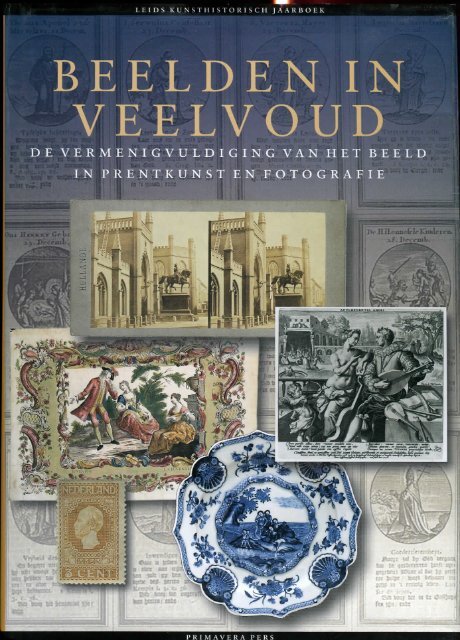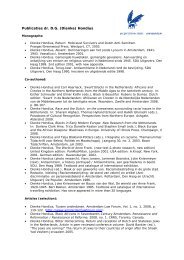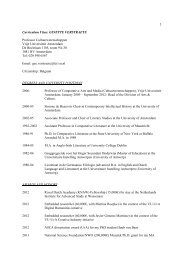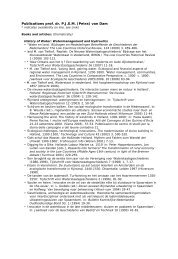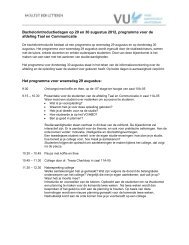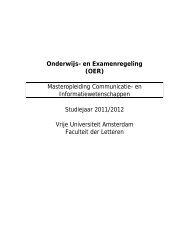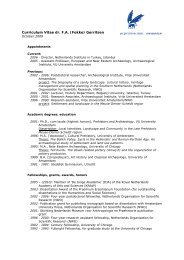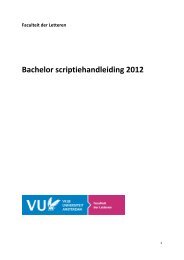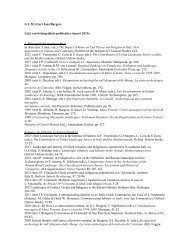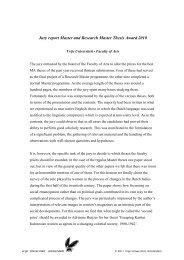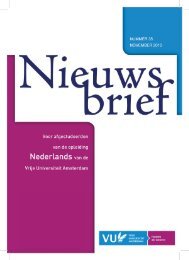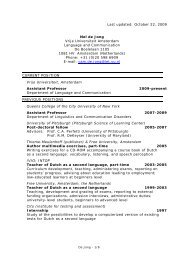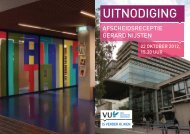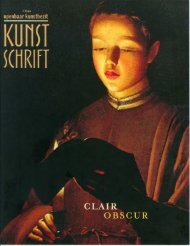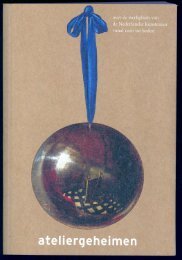You also want an ePaper? Increase the reach of your titles
YUMPU automatically turns print PDFs into web optimized ePapers that Google loves.
LEID S KUNSTHISTORISCH JAARBOEK<br />
<strong>BEELDEN</strong> <strong>IN</strong><br />
<strong>VEELVOUD</strong><br />
E VERMENIGVULDIG<strong>IN</strong>G VAN HET BEEL<br />
<strong>IN</strong> PRENTKUNST EN O GRAF<br />
PRIMAVERA PERS<br />
tm tr<br />
•<br />
-<br />
• '<br />
t?<br />
•
LE1DS KUNSTHISTORISCH JAARBOEK • 12<br />
Beelden in veelvoud<br />
De vermenigvuldiging van het beeld inprentkunst<br />
en fotografie<br />
Redactie<br />
NKLKK BARTKI.<strong>IN</strong>GS<br />
ANTON W. A. BOSCHLOO<br />
BRAM DE KLERCK<br />
HANS UOOSEBOOM<br />
Primavera Pers • Leiden • 2002
Dcz.e uitgave is tot stand gekomen dankzij de<br />
financiële bijdragen van:<br />
-Fonds 1818<br />
- De Gijselaar-Hintzenfonds<br />
-M. A. O.C. Gravin van Bylandl Stichting<br />
- Dr. Hendrik Muller's Vaderlandsch Fonds<br />
-J. F,. Jurriaansc Stichting<br />
© De auteurs; Stichting Leids Kunsthistorisch Jaarboek,<br />
Primavers Pers, Leiden<br />
Alle rechten voorbehouden. Niets uit deze uitgave rnag<br />
worden verveelvoudigd, opgenomen in<br />
geautomatiseerde gegevensbestanden, of openbaar<br />
gemaakt, in enige vorm of op enige wijze, hetzij<br />
elektronisch, mechanisch, door fotokopieën, opnamen,<br />
of enige andere manier, zonder voorafgaande<br />
schriftelijke toestemming van de uitgever.<br />
Voor zover het maken van kopieën uit deze uitgave is<br />
toegestaan op grond van Artikel ree Auteurswet 1972;°<br />
het Besluit van zo juni 1974, St.b. 351, zoals gewijzigd bij<br />
Besluit van 23 augustus 1985, St.b. 471 en Artikel 17<br />
Auteurswet 1912, dient men daarvoor wettelijk<br />
verschuldigde vergoedingen te voldoen aan de Stichting<br />
Reprorecht (Postbus 882,1180 A\ Amstelveen). Voor<br />
het overnemen van gedcclre(n) uit deze uitgave m<br />
bloemlezingen, readers en andere compilatiewerken<br />
(artikel 16, Auteurswet 1912), dient men zich tot de<br />
uitgever te wenden.<br />
All rights reserved. No part of this publïcation may be<br />
reproduced, stored in a retricval system of any nature, or<br />
transmitted in any form hy any means, electronic,<br />
mechanical, photocopying, rccording or othcrwise,<br />
without the prior written permission of the publisher<br />
(copyright bolder), application for which should be<br />
addresscd ro the publisher.<br />
Red act ie-adres:<br />
Universiteir Leiden<br />
Kunsthistorisch Instituut<br />
Stichting Leids Kunsthistorisch Jaarboek<br />
Postbus 9515<br />
NL-13OORA Leiden<br />
Vormgeving binnenwerk: Titus Schulz<br />
Ontwerp omslag: Peter Koch<br />
Druk: AD Druk, Zeist<br />
Afwerking: Van Waarden, Zaandam<br />
Herkomst afbeeldingen op her omslag:<br />
Voorzijde;<br />
Alexis Gaudin et Frère (uitgever), HolLinde N. 28, Paklis<br />
de Guillaume U a. La Hayc (met het standbeeld van<br />
Willem van Oranje), 1858, stereofoto, gealbuminiseerde<br />
zoutdruk, 8,4x 16,7 crn, Rijksmuseum / Rijksprentenkabinet,<br />
Amstetdam (RP-F-FI2O9O); Firma Remondini,<br />
Juventus, ets en gravure, ingekleurd, 5,25 x 77,5 cm.<br />
Rijksmuseum / Rijksprentenkabinet, Amsterdam<br />
(RP-P-2OOO-75); Postzegel 3 cent Willem m, 1893;<br />
Schotel, circa 1735, diameter 22,9 cm, Chinees porselein,<br />
versierd in onderglazuur blauw, Groninger Museum,<br />
Groningen; Crispijn de Passé naar Maarten de Vos.<br />
l.uitspelende jongeman met Venus en Cupido, gravure, 9,1<br />
x 15 cm (Hollsteïnxv, nr. 8>i.[3l), De achtergrond<br />
wordt gevormd door een onversneden suffragia-vel van<br />
F. J. van Tctroode, kopergravure en boekdruk, 40,6 x 26<br />
cm, Museum Catharijncconvent, Utrecht (BMH g6Ö2>.<br />
Achterzijde:<br />
Firma Remondini, Aetas virilis, ets en gravure,<br />
ingekleurd, 52,5 x 77,5 cm, Rijksprentenkabinet,<br />
Rijksmuseum Amsterdam (RP-P-2OOO74); Schotel van<br />
chocoladekop-en-schotel, circa 1745, diameter schotel 13,7<br />
cm, Chinees porselein, versierd in ernailkleuren,<br />
Museum Sypestein, Loosdrcchr; Zonder titel, circa<br />
1850, patroon coll. Landwehr-Vogels, StadsarchicfTiel;<br />
Postzegel 60 cent Nederland, 2000.
7 Voorwoord<br />
9 Inleiding<br />
17 Het gedrukte beeld als historische bron<br />
Enkele methodologische bedenkingen<br />
JAN VAN DER STOCK<br />
35 Tn het kiel water van de schilderkunst?<br />
De functie en de status van de prentkunst in het denken en schrijven over kunst<br />
vanaf de zestiende tot het midden van de achttiende eeuw<br />
NF.LKE BARTEL<strong>IN</strong>GS<br />
65 Michelangelo aan de Rijn<br />
Reprodiictiegrafiek naar Michelangelo in het Leidse Prentenkabinet<br />
JEF SCHAEPS<br />
109 'Veri disegni e gloriosc memorie'<br />
Ceremoniële prenten tijdens de Sede vacante in Barok Rome<br />
M<strong>IN</strong>OU SCITRAVEN<br />
127 Papier in de Nederlanden<br />
THEO LAURENTIUS<br />
137 De tegenstelling, de traditie en de paradox<br />
Relaties tussen tekst en beeld in twee reproducties van Crispijn de Passé de oude<br />
ELMER KOLF<strong>IN</strong><br />
159 Het gebruik van prenten op Nederlands volks aardewerk, circa 1580-1650<br />
FRANS LAUREN'IIUS<br />
167 Prenten op porselein<br />
CHRISTIAAN J. A. JÖRG<br />
177 Bidden voor een 'goede gestchcnissc van de ziel<br />
Suffragia in de Noordelijke Nederlanden<br />
EVELYNE VERHEGGEN<br />
205 De Remondini en hun publiek<br />
ANTON W. A. BOSCHLOO<br />
229 'The most amusing studies'<br />
Thomas Rowlandson en Nederland<br />
PAUL KNOLLE EN HARRIET STROOMBERG
251 Al die cdclvrouwen en goudsmidsdochters<br />
Negentiende-eeuwse kruissteekpatronen naar contemporaine schilderijen<br />
RUTH KRUL<br />
275 Met kunst gcïllnstrcerd<br />
De kunstreproductie in de eerste helft van de negentiende eeuw in Nederland<br />
ANKEMlhK OUXVKRKEHK<br />
295 'Une industrie toute entière'<br />
Over de serie Hollande (1858) en de ontwikkeling van de stereofotografie in<br />
Europa in de tweede helft van de jaren vijftig van de negentiende eeuw<br />
MATTIE BOOM<br />
317 Fotografie in oplage<br />
JAN VAN DIJK EN <strong>IN</strong>GEBORG LEIJERZAPF<br />
339 'Photogrammen in roode omslagen'<br />
Adolphe Eraun dr Cie in het Rijksmuseum<br />
SASKIA ASSER EN ROBERT VERHOOGT<br />
371 Een koningin voor iedereen<br />
Verschijningsvormen en verspreiding van de portretten van Wilhelmina<br />
in het jaar van haar inhuldiging<br />
HANS ROOSEBOOM<br />
389 De dokter en het meisje<br />
Klasse en sekse in de medische foto's van Louis Heijermans<br />
MARGA ALTENA<br />
409 Een foto als voertuig van de macht<br />
Gebruik en hergebruik van Chas Gerretsensportret vanAugusto Pinochet<br />
VERONICA HEKK<strong>IN</strong>G<br />
427 'Spiritus et materïa unum'<br />
De postzegel als tijdsbeeld<br />
PAUL HEFT<strong>IN</strong>G<br />
453 Kandinsky's completion of Eeonardo's Deluge<br />
PAUL VAN DEN AKKER<br />
471 Register<br />
480 Colofon
Kandinsky's completion of<br />
Leonardo's Deluge<br />
PAUL VAN DEN AKKER<br />
It would seem that storrns raged as furiously in the art of the early twentieth<br />
century as they did in that of the early sixteenth. Storms, the Deluge<br />
and the Last Judgemcnt were the central rhemes that inspired Wassily<br />
Kandinsky (1866-1944)to niake his fitst altnost completely abstract paintings,<br />
a development that occurred herween 1910 and 1913. Four centuries<br />
earlier the same themes had been depictcd by his famous predeccssor<br />
Leonardo da Vind (1452-1519) in an equally fascinating series of drawings.<br />
It is assumed that these were also produccd during the first years of the second<br />
decade of a century.1 Yet iconography and date are nor the only similarities<br />
between the deluges of both artists. There is also a striking visual resemblance<br />
(figs. i and 2). At first sight abstract patterns seem to prcvail over<br />
rccognizable, narradve motifs. Upon closer inspection, however, out of the<br />
chaos of forms-and of colours too, in Kandinsky's case —weseeanumber<br />
of figurative clements cmerging.<br />
The question is whether Kandinsky could have seen Leonardo's drawings,<br />
which had already belonged to the Windsor collection for a very long time.<br />
During the period around 1900-13 the drawings were ncvcr cxhibitcd outside<br />
England and Kandinksy never visited this country. As a matter of fact<br />
it seems unlikely that Kandinksy, who was famous for his non-figurativc<br />
art, drew inspiration from Leonardo's work. Did nor the latter's figurative<br />
illusions belong to an art-historical period which in Kandinsky's time,<br />
wirh the rise of abstract art and not least with Kandinsky's own work, was<br />
assumed to have come co an end once and for all?<br />
Similarities in art are seldom coincidences. Even though it is unlikely that<br />
Kandinsky ever saw Leonardo's original drawings, hè must have known<br />
them, as we will see later, from reproducdons. And even though hè seldom<br />
mentions Leonardo's name in his writings, when hè does so, it is positively.<br />
In Uber das Geïsüge in der Kunst (1912) hè called him 'der grosse, viclscitigc<br />
Meister' and his admiration for Leonardo fits in, as we will see, with the<br />
reevaluation of this artist that had been going on since the middle of the<br />
ninetcenth century.2<br />
KAND<strong>IN</strong>SKY S COMPLETION OF LEONARDO S DELUGE 453
454<br />
Paul van den Akker
SOQ^VNOHT s AHSNIQNVS<br />
•suoiaEpiinoa. p|[os S3T saidsap spjBD jo ssnoq E aijij<br />
§UIsdB[IO3 Xjp B tpTAV JDJSBSIp Slip oUÏJEduiOD 'SSUUlEaJSO J3UIJOJ J [B JO 33UE<br />
sip pDaDipsad put asijdojd B jo 3|oa sqa psadops 3q '(uon<br />
sSusp;^ 'JsadBip pjiip stp u| 'ipods pmamds '<br />
B Aq p33Ejd3a 3q usip pjiiOM J.T atip pue 'ujsi|BU3:)Eui Xq SEA\i SB<br />
'3-injTEj 03 p3iuoop XjqEaiAsuT SEM. sXïp SILJ jo 3jni|nD Dip acip<br />
u j UT ui Xü|dpmoqs SÏSHJÏ; put; JJB ujgpouj<br />
jo au3iudo[9A3p sqa inoqï SB3pi sii| oj paa^jgj Xpsop SEM<br />
UIJO1S E JO 33U3TJ3dx3 3^4 35[OA3 pjHOM 1BI]3 3-TE UB JO 3Z>TOU_D S(A3jSUTptTE^J<br />
'OUST J3A\.SUE3qj_^3ZIU§O33JOapU|LU3I[a JOJ SlIllpOU pUE S3/3 3lp JOj §UILj3<br />
-3LUOS p3J3gO A[UO JjJOM 3qi JBtja 'J3aE| 31OJA\g SE 'U3l|3 3SED 3^4 }T SJ<br />
^-sSnpp 3iji jo Xjoas sip 03<br />
33U3J3J3J XuE ptOAE Ol SE OS '/yj UOtflSOrflUO^ '3pU [BJ1H3U E JOJ p3ldo U3L]1<br />
3TJ[ 'SEAUED 3oJE] 3lp JUl^d Oï S/Ep 39JI[a JO OM1 UIITJ 5[OOa X|UO II '31OJM J|3S<br />
-UIIU3USE :3S-inODJO J3J3EUIE SE MO[|O-f p|nOM JS3J 3l|J pUB S3Lll| pUB SJT1OJOD<br />
JO 333-9:3 [EUOUOUJ3 3lp UO X|3ATSnpX3 3JBJ3U33UO3 O3 J3IIJEJ p3p[33p 3JJ<br />
•Xjois sip qaiA\d sqa SJBTDOSSB oa psoaoj 3q pynoAv JSMSIA sip SSRED<br />
-3q 'oUU3BJ3SIp 3q X[UO p|HOA\1 3DUIS 'saU3UI3p 3A)aBjn3lJ jno §U1AB3|<br />
Xq p3A3ii|DE sq AJUO p|no3 |BO§ stqa 3Eip A\3Uïj 3ij puy '3§npp E oj suonoura<br />
jE[iujis §ui5[OA3 'jpOA\B UB sq pssasui pjnou,s :nq 'sgnpp 3i[]<br />
jo Xiois 3i|4 XEjjJod X||EJ3ai[ aou pjnoijs §unured siq<br />
§UOaA\3 UO SBM. 3LJ IBq] LUTq OJ p3JJ1133O XjU3ppllS 31 UIBA UI<br />
E pUE JE3X B .I31J13 3tig '§U]JUTBd 3§JB| B O1U1 (f '<br />
'J3||EUIS B 3aB|SUEJ3 O3 pappop 3q<br />
ij -SunuiBd siqi jo stssuaS snouoqB| XHEHTUT aqa jo<br />
UB 3AB§ 3L[ q31l|A\T (U3ZUO|\Jj S^ïjSUIpUE^f p3UIB3UOD OS|E<br />
Xq p3i|ST|qnd Xpnis srq j_ -£161-1061 tyswpuvy UT a] jo uononpoid<br />
-3J E<br />
UB^ JA UOUKOdwO^ p33Tlp0.ld 3q SE JE3X 9UJES 3^3 UJ<br />
•3sodjnd uo STU^ pip ïpiiBjg ^[uiqj<br />
oj psuipüi asoui|E ST suo puB imop-spisdn p33npo.id3J SEAV //\<br />
-tUO^ t'?\SBJ^ J3§UO| OU UEO 3M. 3Tiq §Uiqj3UJOS 33S ||ps UB3 3A\R S3S1UI<br />
-oad >|Ooq siqi jo spp 3qj jBqj saii_ui| 3qa pai|3B3.T X|njj SAEIJ SA^ 'p3pn[3uo3<br />
>[OOq Siq '((UOTÏTSOduiO^)M S/^SUTpIIE^ l{31^, U3A3AVOq 3npJA DpSllJE XlIE UI<br />
§UTi|3E[ SEA\3 M3IA Siq UT 3SUods3J B SBM 31 ïX^SUTplIB^ §UIpTlpLIT 'SJSUJB<br />
ISTUOTSSaidxg 3LJ3 JO 5JJOM 3qj UI UISILlOISSSjduiy JSUre§E LIO113B3J |BDIJO1SILJ<br />
3jqiniA3ur HE psunu^ps jpuBjg 'ÏJB asTAgqsiog .10 'XaEuopn|OA3jjo 3|dLUEX3<br />
|E3idXi E SBM ai uiiq JOJ 'SUOUBAJSSSJ suaos qiTA\s pyp sq 'uauuaq^ pun<br />
>[ooq jBpidod siij jo uontpa qainoj 3qa ui iz6i UT ai pspnpui apuEjg<br />
usq^ -asnjasip ps>[OAoad OSJE 'sSnpp sqa jo guisip 3qa uo psssq<br />
o (i -§u) /yj uonisoduio^ sijj[ -uBiupEUi E jo ^JOA\a SB ai p3qn3sop<br />
J3M3IA3J 3UO 'U3q3UH]AJ §UU§IUI3J3AJ3pSlirr>[ D113f\ 3qa 4E p3a]qiqXO SBM ƒƒ<br />
UOtJtSofóuO^ STIJ OTÓT UI U3q^ 'S3UTJD 3l[a UIOJJ [|B 3AOqE '31UODJ3M<br />
E p3AI3D3J OS[B >[JOM SIl] 'SUIJOaS Xq pSJldsiIT ASï[UTpïIF)J SEA\O<br />
WIV S ASSN IttNV^ï<br />
'UI3 É'OZ<br />
'IDUI/Y Ep OpJÏUO3-J<br />
3i[j^'ui3 oo£ x S6i<br />
'SEAUED UO JIO<br />
'£161 7/1 uonisoduw^<br />
'Aï|SUTpUE^J lijISSBM 'J
j. Wassily Kandinsky<br />
Deluge (smdy for<br />
Composition VI),<br />
circa 1912, palnrlng<br />
on glass, dimensions<br />
and location<br />
unknown.<br />
Kandinsky wanted his abstract paintings ro have a similar emotional effect<br />
to that of the purifying cosmic catastrophes hè anticipated, and hc uscd an<br />
asyetunfamiliar, veiled languageof forms to evoke the newworld that was<br />
yet tobecreated.5 He wasdelighted then with thepoem 'An Kandinsky' by<br />
the Dutch symbolist poet Albert Verwey, which is like a version in words<br />
of the experience hc wanted his art to evoke. In the German translation<br />
made by Karl Wolfskehl for Kandinsky, the poem opens with the words<br />
'Seele nun sieh gleich dem leuchtenden Morgen' (Look my soul: like the<br />
morning light). Among othcr things the soul sees 'The essence of all that is<br />
iiquid orvapour or mass', 'Cuttinglines thattear through the void', 'Circu-<br />
lar movement that sin^s in the air' and 'Eddics and swirlins of colours and<br />
o o<br />
lines'.6 In Verwey's terms at any rate Kandinsky seemed to have reached his<br />
goal and the poem was given an honoured place in Waldcn's study mentionedabove.<br />
Does the omission or disguising of all figurative elements mean that<br />
Kandinsky's formal idiom was in fact the product of a visionary mind that<br />
could see what nobody had secn bcforc? In the art-historical literature on<br />
Kandinsky much attention is paid to the visual sources which inspired his<br />
development towards abstraction. Some authors have pointed out iconographical<br />
and stylistic similaritics bctwecn motifsin Kandinsky's work and<br />
Ülustrations in theosophical writings from the beginning of the twentieth<br />
century such as those of Annie Besant and C. W. Leadbeater with which<br />
Kandinsky was familiar.7 Others have pointed to connections with images<br />
456<br />
Paul van den Akker
ftom Russian folk art and ethnographicobjects,8 and with the works of Jugendstil<br />
and Symbolist artists living and exhibiting in Munich, the city to<br />
which Kandinsky had moved in 1896 from his native country Russia at the<br />
age of thirty-six and whcrc hè had received his first training as an artist.9<br />
Strangely however, the name of Leonardo da Vinci is never mcntioned.<br />
MEREZHKOVSKY<br />
Kandinsky was not the first to believe m a future Apocalypse and an inevitable,<br />
cultural revolution. In the nineteenth century more and more<br />
writers had discusscd these themes, convinced as they were that the course<br />
of human history was an evolution through a number of major clearly<br />
dcfined periods and that man wouid eventually reach a spiritual level. In<br />
keeping with Hegcl's ideas on the progress of human culture, philosophers<br />
and historians proclaimed that the spiritual epoch had already dawned or<br />
else was just round the corner. At the end of the century this belief in a spiritual<br />
progress had also become widespread among artists and poets.<br />
His years in Munich and his stay in Paris in igoó-'oy gave Kandinsky every<br />
opportunity to become acquainted with such eschatological and messianistic<br />
ideas. He also came into contact with notions of the role of the artist<br />
and poet as advocate and preachcr of the coming era. Just as his writer<br />
friends chose an Expressionist style of poetry to give voice to the new era,<br />
so hè and other artists became increasingly persuadcd that the artist's solution<br />
was to paint in a more abstract style, leaving out or disguising figurative<br />
forms.10 Kandinsky drew inspiration for this dcveloprnent not only<br />
from the Russian and French symbolist poets and writers, hut also from<br />
the theosophical ideas and the mystical writings of Joséphin Péladan, the<br />
spokesman of the Rosicrucians.11<br />
In Munich hè maintained close relations with the Russian Symbolists and<br />
would thereforc have known of their admiration for Leonardo, whom they<br />
hailed as a forerunner who had played a vital role in one of the great cultural<br />
revolutions. According to them, Leonardo was a seer of great genius, a mysticand<br />
a pioneer of what was then the new, modern mode of thought.12<br />
Among the Russian symbolists, it was Dmitry Merezhkovsky who was<br />
most eloquent in his admiration for Leonardo. In 1901 hè even wrote a historical<br />
novel about this Renaissance artist, The Rebirth ofthegods: Leonardo<br />
da. Vind.13 Merezhkovsky moreover srood out among the Russian symbolists<br />
with his conviction that history had always been characterized by greac<br />
upheavals and that the last of these was about to break out, leading to a<br />
third, new epoch.14 It was within the framework of this vison of history<br />
that hè presentcd Leonardo as a figure viewed by his contemporaries as an<br />
Antichrist.<br />
In his novel Merezhkovsky presents Leonardo's apprentice, Giovanni Bcl-<br />
KAND1NSKY S COMPLETION OF LEONARDO S DELUGE 457
affio [sic], as an admirer and witness of hls master's deviant and revolutionary<br />
ideas. The sixth chapter is entirely devoted ro h is diary in which hè<br />
jotted down Leonardo's pieces of artistic wisdom, and his recommendations<br />
and formulas. In one of his more extensive notes hè relatcs<br />
Leonardo's explanation of how one should depict the Delugc. In the<br />
English translation of 1931 this note reads as follows:<br />
'Discoursing of how an artist ought to compose the ideas for pictures,<br />
the master told us, by wayof an example, of a representation of the delugc<br />
that hè had conceived: 'Abysses and maelstroms, lit up by lighcnings.<br />
Branches of enonnous oaks, with people clinging to them, carried<br />
along by a waterspout. Waters, strewn with fragments of household<br />
furniture, upon which people seek to save themselves. Hcrds of<br />
quadrupeds, surrounded by water, on high table-lands, — some with<br />
their Icgs on the backs of others, crushing and trampling one another. A<br />
horde of people, defending, with arms in. hand, the last patch ofground<br />
from fcral beasts. Some are wringing their hands, gnawing them so that<br />
the blood runs; others stuff their ears so as not to hear the rumble of the<br />
thunder-sbocks; or else, not content with having shut their eyes, place<br />
one hand atop the other, pressing them to their eyelids, in order not to<br />
see their impending death. Some commk suïcide, suffocating, strangling<br />
themselves, impaling themselves upon swords, casting themselves<br />
into the raging deep from cliffs; and mothers, cursing God, seize their<br />
children to smash their heads against stones. Decomposed corpscs float<br />
up to the surfacc, colliding with and striking one another, and rebounding<br />
like little balls inflated with air. Birds perch on them; or,<br />
sinking down from exhaustion, descend on the living men and animals,<br />
finding no other place to rest.'15<br />
Kandinsky himself refers to a German transiation in U b er das Geestige.16<br />
Although hè does not mention the passage about the deluge, hè can hardly<br />
not have known it. Given Kandinsky's belief in past and future cultural<br />
revolutions, this passage must have sounded like a call to arms.<br />
Merczhkovsky's novel may have inspired Kandinsky to deal with the theme<br />
of the deluge, or at any rate stimulatcd his interest in it.17 Yet to what extent<br />
was the novel helpful to him in finding a suitable formal idiom? His<br />
earlier, paraphrased description of the origins of Composïtion VI proved<br />
that in around 1913 Kandinsky had already experienced a great deal of<br />
difficulty in depicting the story of the deluge. In the earlier littie painting<br />
on glass based on the same subject (fig. 3) hè stïll included 'various figurativeforms,<br />
partlycheerfulones (Igotalotof pleasureout ofcombining the<br />
serious forms with cheerful external images): naked figurcs, arks, animals,<br />
palm trees, lightning flashed, rain, etc.'.18 But with regard to more serious<br />
forms of art — hè had made the glass painting more for his own pleasure<br />
/icS Paul van den Akker
(zum meinen Vergnügen}- Kandinsky had learned in Munich that the figurative<br />
belonged to che past, rather than to modern art. In this regard then<br />
the novel could not have been of much direct use.<br />
Nevertheless the homage paid to Leonardo by Merczhkovsky and many<br />
other Russian and European Symbolists may weli have arouscd Kandinsky's<br />
curiosity about Leonardo's own texts and drawings of the delugc.19<br />
While we do not know which publications and reproductions hè consulted,<br />
we can discern a few likely candidates.<br />
TKXTS BY AND ABOUT LEONARDO<br />
Since the middle of the nineteenth century a new historica] and aesthetic<br />
image had emerged of Leonardo as aseer of genius, a sort of mystical magician.<br />
Initially an invention of French authors, the 'new' Leonardo also<br />
made an appearance in the works of English and German writers from the<br />
late i86os onwards. Tn England Walter Pater in particular represemed chc<br />
new Europe-widc interpretation of Leonardo. In his famous and influential<br />
essay of 1869 hè dcscribed Da Vinci's art from a modern aesthetic point<br />
of view and the person of the artist in a historical, if somewhat unconvcntional<br />
fashion. According to Pater, Leonardo's artistry, which hè found<br />
both rnysterious and modern, could only have originated from chc brain of<br />
a profane genius far ahead of his time.20 Pater saw him as the personification<br />
of the greac upheaval that supposedly occurred in around 1500; hè<br />
was 'the sorcerer or magician, possessed of curious secrets and a hidden<br />
knowledge, living in a world of which hè alonc possessed the key'.21 This<br />
was the Leonardo for whom the Symbolists feit such admiracion.<br />
The veritable deluge of works on Leonardo all elaborated on this interpretation.<br />
Among them was a book of 1892 by Gabriel Séailles, that received<br />
great acclaim at the time, Léonard de Vind; l'artiste et ie savant. Essai de biographie<br />
psychologique. Séailles devoted a large part of the chapter, 'Le savanc<br />
et l'artiste: la science dans l'art. — Les procédés et les ceuvres' to Leonatdo's<br />
own remarks on the depiction of a deluge and the accompanying "Windsor<br />
drawings.<br />
Séailles accounted for the rnysterious power of the lacter by referring to<br />
Leonardo's exceptional combinacion of true obsetvation of nature and understanding<br />
of the spirit (I'esprit) that was present in all creation. He saw<br />
these drawings as outstanding examples of Leonardo's genius. Like Walter<br />
Pater, hè mentioned Leonardo's exceptional fascination with the movements<br />
of water, which hè had observed so intensely that his drawings of<br />
eddying whirlpools and rolling, buffeting and breaking wavcs suggest that<br />
Leonardo had done his deluge from direcc experience. Rather than a trueto-Ufe<br />
rendering, realistic chough the details are, one of the deluge drawings<br />
reminded him of the vision of a poet such as Dante.<br />
KAND<strong>IN</strong>SKY S COMPLETION OF LEONARDO S DELUGE 459
'Penetrating to the heart of nature deeper than nature itself- that is his<br />
dream. It is the ambition of a cold-blooded Prometheus, who instead of<br />
insultingjupiter, studies hisworkson hisbehalf to discover their secret.<br />
As an artist all hè asks of knowledgc is the power to create, to give life.'22<br />
Séallles' interpretation of Leonardo's drawings as the expression of a visionary<br />
dream would probably have appealed to Kandinsky. The samc goes<br />
for Eugène Müntz's ideas in hïs Leonard de Vind; l'artiste, lepemeur, Ie savantof<br />
1899. Müntz saw Leonardo's texts on storms and the deluge - to<br />
which hè however devoted less attcntion than Séaiiles — as proof of an exceptional<br />
poctic genius. Da Vinci might have been inspired by Petrarch<br />
and his texts also vied with Virgil's dcscriptions of nature in his Georgics;<br />
'lóth century Italian literature has produced nothing better in the field of<br />
descriptive poetry, the recording of landscapes, or of chc phenomena of the<br />
atmosphere and of light'.23 According to Müncz, these poetic descriptions<br />
'of the Zephyr and the storm' (de Zéphyr et de l'ouragan) demonstrated Leonardo's<br />
ability to go to the heart of divine nature (l'essence divïne); they also<br />
cestified to his sense of his affinity with God, who both creates and destroys.<br />
The prevailing image of Leonardo was thus expanded by Séaiiles and<br />
Müntz and this formed the framcwork for their analysis of his writings<br />
about and drawings of the deluge and storms. Moreover they could draw<br />
on recent editions of Leonardo's texts. The fashionable interpretation of<br />
Da Vinci's work had also created a dcmand for biiingual publications of his<br />
writings. There were successive editions in the i88os in Germany, England<br />
and France, all of them including the texts on the Deluge and on storms.24<br />
The extract in Merezhkovskv's later novel, the note that is in Beltraffio's diary,<br />
is just a very concise summary.<br />
Leonardo's original instructions for illustrating a storm and the Deluge are<br />
too numerous anddetailcd to quote here in full, so I will confine myself to<br />
itemizing the most salient motifs not mentioncd in Merezhkovsky's novel<br />
— the downfaü of cities whose walls and high buildings are shattered by the<br />
forces of nature; ships that capsize or are wreckcd by the fury of the waves;<br />
forests on fire; landslides; broken boulders that fall into the torrents,<br />
blocking thevalleys andcausing chcswollen rivers to break their banks;eddying<br />
whhipools; heavy downpours of rain in the atmosphere; waves<br />
brcaking against each other or against cliffs or rebounding off various drifting<br />
objects only to surge up as foam into the air before falling back; a sky<br />
full of scactered clouds and of the dust thrown up by horses as they panic<br />
and bolt and by the broken pieces of rocks and buildings, rendering the<br />
motion of the wind and currcnts of air visible.25<br />
Reading Ober das Geistige in der Kunst, one can hcar the echoes of Leonardo's<br />
account of the down fall of cities. If Kandinksy did indeed consult<br />
a translation of Da Vinci's Trattato della Pittura, it may have been the<br />
460 Paul van den Akker
German version by Heinrich Ludwig of 1882. Yet I thmk that more recent,<br />
French verslons of the beginning of the twcntieth century would have appcalcd<br />
to him more. They were edited by the abovc-mentioned Joséphin<br />
Péladan who, like many other contemporary mystics and symbolists, had<br />
an exceptional aesthetic and historical admiration for Leonardo. He had<br />
shown this already in his earlier texts on art and mystical writings, in which<br />
hè also appearedas an advocate of the Ordre de la Rose + Croix+ Catholique,<br />
proposing Leonardo as its patron saint.26 Péladan was no stranger to Kandinsky<br />
who mentioned him in Ober das Geïsüge and who had paraphrased<br />
a statement by Péladan, 'Artist, thouartking' (Artiste, tuesroï) from atext<br />
of 1894 in which hè also rcferred to Leonardo.27<br />
Péladan followed up his small anthology of 1907 of Leonardo's texts including<br />
the passages on the depiction of the deltige and storms, by editing<br />
the first annotated French translatïons of Leonardo's treatise on painting<br />
and his discussion on landscape painting, that hè thought was a separate<br />
treatise.28 This was, incidentally, the year that Kandinskydecidcd to abandon<br />
the depiction of fairytale themes and turn instead to deluge and<br />
storms.<br />
The tone of Pcladan's introduction to Leonardo's treatise on landscape<br />
painting not only resembles that of Kandinsky's writings; it also comains<br />
similar aesthctic judgements. According to Péladan, no-one had summed<br />
up 'the l aws of the pure landscape' (les lois du paysage pur) as wel! as Leonardo<br />
had done in his treatise on landscape (includïng scènes of the deluge<br />
and storms), thus giving voice to 'clemental life and all that is cosmic' (la<br />
vie élémentaire et l'aspect cosmique). According to him Leonardo's treatise<br />
taught us to reaüze the mystery and divinity of natura! phenomena. In his<br />
short account of the aesthetics of landscape painting, hè thcn stressed that<br />
a landscape should always be imbued with a soul, praising the classical<br />
painters for this quality. In his view, they 'had such a deep understanding<br />
of nature, that they have given ït a soul and a person, pcopling it with invisible<br />
beings'.29 What rcally martered for Péladan was that each type of<br />
landscape gave rise to a different kind of emotion depcnding on the light,<br />
the colour range and the artist's sensïbility.30 Leonardo's text also demonstratcd<br />
how wrong it was to think that landscape was an easier genre than<br />
Tables et [...] histoires'. Kandinsky having toïled on his Composition VI<br />
would have applaucled this. And in his description of ïts creation Kandinsky<br />
too emphasized that making art is a matter of an effective organïzation<br />
of colours and tones rather than figurative representatïon.<br />
REPRODUCTIONS<br />
As said above. Kandinsky's curiosity must have concerned Leonardo's<br />
drawings just as much as his texts. Péladan's edïtions were nor much help<br />
KAND<strong>IN</strong>SKY'S COMPLETION OF LEONARDO'S DELUGE A_6l
4-Jean Paul Richter,<br />
77j
). Leonardo da Vinci,<br />
Deluge, after 1513,<br />
black chalk,<br />
16.1 x 20.7 cm,<br />
Windsor Castle,<br />
Roval Librarv, no.<br />
vures of Leonardo's drawings, among them some of chc deluge and storm<br />
drawings (fig. 4). He secms to have aimed to reproduce them full-size and<br />
co imitate theoriginal paper coiour. Ie was from Richter's bookthatMüncz<br />
borrowed his illuscrations and Séailles and Péladan also rcfcrred to it in<br />
their texts on the drawings in qucstion. Whatever text about Leonatdo<br />
Kandinsky may have read, in his quest for reproductions hè was bound to<br />
have come across Richtcr's publicarion. The list of subscribcrs in Richter's<br />
book does nor include Kandinsky's name; other artists and che 'Royal Pinacoteca'<br />
in Munich, Kandinsky's city of resïdence are however inclu-<br />
ded.-54<br />
Not all of Leonardo's Windsor drawings of deluge and storms were published<br />
in Richter's book. Many years later, but still before Kandinsky embarked<br />
on his deluge and storm paintings, the French publisher Edouard<br />
Rouveyre changed all rhis. The appearance in 1901 of hïs 23-volume cdition,<br />
Feuillets inédits, repwduits d'après les originaux conservés a la Bibliotbèque<br />
du Chateau de Windsor, fuift lied a long-feit need for reproductions.<br />
With its facsimiles of a great number of chc Windsor drawings arranged<br />
according Co subject, it functioned as a mine of visual information. In his<br />
preface Rouveyre strcssed that his book was intended for a broad public as<br />
wcll as for scholars and artists. In mvview, it is in these Feuillets médïtsthat<br />
KAND<strong>IN</strong>SKY S C O M P L E T I O N OF LEONARDO S DELUGE 463
6. Wassily Kandinsky,<br />
Improvhatlon Deluge<br />
(Large Studyfor<br />
Composilion VI),<br />
1913, oilon canvas,<br />
95 x 150 cm,<br />
Stadtische Galerie<br />
ini Lenbachhaus,<br />
Munich.<br />
we find the most likely candidate for Kandinsky's final vïsual source —<br />
namely, the volume devoted to the deluge and storm drawïngs.35<br />
The title of Rouveyre's volume is Études et dessins sur l'atmosphère. The term<br />
'atmosphere' was already used in 1899 by Müntz to characterize Leonardo's<br />
drawings of the deluge and storms and it was therefore also adoptcd by<br />
Pcladan in 1910. Tt is remarkable that the same term often turns up in<br />
Kandinsky's Überdas Geisiigewho uses it to refer to the invisible realm of<br />
inner thoughts and emotions.36 As already said, Kandinsky thought hè<br />
owed it to his own time and to posterity to depict this spiritual atmosphere<br />
in a non-figurative way, thus abandoning the Renaissance tradition of<br />
which Lconardo was such an outstanding representative. The important<br />
thing to stress however is that: in comparison with his written texts, Leonardo's<br />
own drawings seem to testify ro a quite different, almost non-Renaissance<br />
approach towards the dcpiction of storms and the deluge (fig. 5).<br />
It is as if decorative patterns prevail in them over narrative details, making<br />
these drawings look like further evidence to support the notion that hè was<br />
an avant-garde artist long before this term was devised. In 1903, for example,<br />
Bernard Berenson dcscribed them as being full of'poetic force and<br />
decorative beauty'.37 Kandinsky himsclf must have seen them as the expression<br />
of a kindred artist, one who was concerned above all with the<br />
composition of abstract patterns of repetitive and parallel curving Unes and<br />
of overlapping or juxtaposed amorphous forms, rather than with creating<br />
illusions. This must surely have been the decisive reason for him to embrace<br />
Leonardo's drawings with such fervour.<br />
464 Paul van den Akker
7- Detail of fig. i.<br />
8. Detail of fig. 5.<br />
Like his grcat predecessor, Kandinsky confronted the viewer in the first instance<br />
with a composition compietely filled with abstract patterns, colours<br />
and lines that overlap or clash with each other. AJthough depth is suggested,<br />
it seems impossible to jndge the discance between the different<br />
forms. Kandinsky's Improvisation Deluge from 1913 {fig. 6) is virtually a<br />
colour translation of Leonardo's drawings of the deluge (fig. 2). It is as if in<br />
the lighter parts of Composition VI (fig. i) hè had followed Leonardo's advicc<br />
to depict mist and to make the air less dark at places where the sun's<br />
KAND<strong>IN</strong>SKY S COMl'LETION OP LEONARDO S DEIUGE 465
ays break through. Kandinsky himsclf distinguished three centres in this<br />
composition, of which the middlc and most important one, 'floats in the<br />
air rather and looks as though it is surrounded by vapours*.38 Some of the<br />
waveüke patterns in this painting (fig. 7) resemble abstractions of Leonardo's<br />
already fairly schematic clouds or waves (fig. 8). There are also striking<br />
iconographical similarities. Kandinsky's compositions are full of reminiscences<br />
of the kind of figurativc clcments that on closer inspection cmerge<br />
out of Leonardo's drawings — thimderbolts, panic-stricken figures, trees<br />
bendine o to the o°round<br />
and devastated cities. And even the addition of the<br />
recurrent motif of the boat with oars, which does not occur in the Biblc<br />
story of the Delugc or in the Apocalypse, suggests that Kandinsky was following<br />
Leonardo's recommendations.<br />
The similarities bctween Kandinsky's and Leonardo's dcluges and storms<br />
then are not merely iconographical, but above all visual. During the epoch<br />
when Kandinsky was producinghis compositions, Leonardo wasvicwedas<br />
a rich and prestigious source of inspiration for many; it was within this tradition<br />
that Kandinsky followed the cxample of the 'grosse, vielseitige<br />
Meister', as hè had called him. Like Merezhkovsky's Leonardo, hè acted as<br />
the champion of new ideas that were quite unfamiliar to most of hts contemporaries.<br />
And just as Da Vinci's drawings were treated by art historians<br />
as a group, so Kandinsky presented his first seven Compositions as a coherent<br />
series based on the theme of purifying catastrophes, completing the series<br />
in 1913 with Composition Wand Composition VIL<br />
Richter, Merezhkovsky and Péladan had all pointed out that Leonardo<br />
must have planned a painting of the deluge and one of a storm. They also<br />
added however that this project was never carried out, so that only Leonardo's<br />
dcscriptions and drawings remain. Perhaps it was this remark that<br />
prompted Kandinsky to recreate the storms that Leonardo had foreseen,<br />
unleashing them fourcenturies later even more powerfully — and incolour.<br />
(Translated by Donald Gardner)<br />
466 Paul van den Akker
NOTES<br />
r In about 1910 Leonardo's drawings were dated as<br />
around 1510-13. Currenrly rhey are darcd as af ter<br />
1513: C. Pedrctri, exh. cat. Zürich (Kunsthaus<br />
Zürich), Leonardo dn Vind: Natur und Landschaft;<br />
Naturstudien aus der Königlichen Bibliothek in<br />
Windsor Caslle, Zürich 1983, p. 47-50, cat. nos.<br />
30-508.<br />
2 W. Kandinsky, Ober das Geistige in der Kunst,<br />
Munich 1912, p. 85.<br />
3 'Mït der "Komposition" Kandinskis sind wir nun<br />
tatsachlich an den Grenzen angclangt, die der Titel<br />
dieses Buches uns steekt: zu sehen vermogen wir<br />
noch, aber nicht mehrzu erkennen.': P. Brandt,<br />
Sehen und Erkennen; eine Anleïtung zu<br />
vergleichender Kunstbetmchtimg, Stuttgart 1921,<br />
p. vi-vi!,p, 333.<br />
4 W. Kandinsky, 'Komposirion 6', in: Kandinsky<br />
1901-1913, Berlin, p. xxxv-xxxviii.<br />
5 See forinscance S. Ringbom, Thesoundingcasmos;<br />
a stuely in the spirituatism of Kandinsky and the<br />
genesis of abstract paiming, Hclsingfors 1970,<br />
p. 162-185.<br />
6 'Ursinn von Feuchtc und Dampf und Grund',<br />
'Linien die schneïdend den Abgrund zerreisscn',<br />
'Rïngclndes Weben das Lüfte dnrchzucki', 'Wirbel<br />
und Wurl von Farb und Gezack': P. Wciss,<br />
Kandinsky in Munich; theformatïveyears, Princeton<br />
NJ 1979, p. 82-83,151,192, note 27.<br />
7 See for insrance Ringbom, op. c/t. (note 5); idem,<br />
'Transcending the visible: the generation of the<br />
abstract pionecrs', exh. cat. Los Angeles (County<br />
Museum of Art), Chicago (Museum of<br />
Contemporary Art), The Hague (Haags<br />
Gemeentemuseum), The spiritual in art; abstract<br />
painting 1800-1985, New York 1986, p. 131-153; R.-C.<br />
Washton Long, Kandinsky: the devdopment of an<br />
abstract styie, Oxford 1980, esp. p. 13-41.<br />
S Washton Long, op. dl. (note 7), p. 75-87; Eadem,<br />
'Expressionism, abstraction, and the scarch for<br />
Utopia in Germany', The spiritual in art, op. cit.<br />
(note 7), p. 201-217; P- Weiss, Kandinsky and old<br />
Russia; the artistas ethnographer and shaman, New<br />
Haven, London 1995.<br />
9 Weiss, of. cit. {note 6).<br />
jo Weiss, op. cit. (note 6); R. Heller, 'Kandinsky and<br />
Lraditions apocalyptic'. Art Journal (Spring 1983),<br />
p. 19-26.<br />
ii Washton Long, op, cit. (note 7), p. 13-41; John E.<br />
Bowlt, 'Vasilii Kandinsky: the Russian connection',<br />
in: J. E. Bowlt, R.-C. Washton Long (eds.), Thelife<br />
of Vasilii Kandinsky in Russian art; a study of On the<br />
spiritual in art, Newtonvillc Mass. 1980, p. 2-41;<br />
Ringbom, op. cit. (note 5), chapter v; M. Dabrowski,<br />
exh. cat, New York (The Museum of. Modern Art),<br />
Los Angeles (Gounty Museum of Art), Kandinsky;<br />
compositions, New York 1995, p. 17.<br />
12 E. Hüttinger, 'Giorgione- und Lconardo Kult', in:<br />
R. Baucr et al., Fin de siècle; zu Literdtur und Kunst<br />
der Jahrhundertwende, Frankfurtam Main 1977,<br />
p. 143-169; I. Gerards, E. van Uitcrt, 'JanToorop;<br />
een "fabuleuze bevatrdijkheid": het symbolistische<br />
scheppen', Jong Holland) (1:989), i, p. 8-9; R. A.<br />
Turner, Inventing Leonardo, Berkeley, Los Angeles<br />
1994, p. 100-149.<br />
13 D. Merczhkovsky, Voskressie bogi: l.eonardo Da<br />
Vind, 1901.<br />
14 Ringbom, op. cit. (note 5), p. 175; Heller, op. cit.<br />
(note 10), p. 22-23.<br />
15 The English quotation is froni D. Merejcovski,<br />
The romance ofl.eona.rdo da Vind (translated by<br />
B. Guilbert Guerney), New York 1931, p. 172-173.<br />
In the German translat-ion used by Kandinsky this<br />
note read as follows: 'Er sprach davon, wie der<br />
Kiinsrlcr die Kompositionen zu seinen Bildern<br />
entwerfen soll, und führte uns als Beispiel die von<br />
ihm geplante Darstellung der Sintfiuc an:<br />
"Von Bliezen erleuchrete Wirbel und<br />
Wassers c rudel. Von einer \Vasserhosc fortgerissenc<br />
Aste rïesengrosser Eichen, an die sich Menschen<br />
festldammern. Schwimmende Trümmer von<br />
Hausgeraten, auf denen sich Menschen zu retten<br />
stichen. Herdcn von Vierfüsslern aut hochcbenen,<br />
von allen Seiren von Wasser bedroht; die Tierc<br />
steigen aufeinander, crdrücken und zerstampfen<br />
eïnander. Ein Hauren von Menschen, die den<br />
Ictzten Elecken Erde mie Waffcn gegen Raubtiere<br />
verteidigcn; die eincn ringen die Ha'nde und<br />
heissen sie so, dass Blut m'esst, andere halten sich<br />
die Ohren zu, um das Gedröhneder Donner nicht<br />
zu horen, wahrend andere die Augc schliessen und<br />
noch obendreln beide Ha'nde übercinanderlegen<br />
und sie so gcgen die Augcnlider pressen, um den<br />
nahcnden Tod nicht zu sehen. Andere begehen<br />
Selbstmord: sie erdrosscln sich, erstcchen sich mit<br />
den Schwettcrn, oder springen von den Klippen in<br />
die Hut. Mütter crgreifen, Gott verfltichend, ihre<br />
Kinder, und zerschcllcn ihre Köpfc an den Felsen.<br />
Derwescnde Leichen schwimmen auf der<br />
Oberflachc; sic stossen zusammen und prallen<br />
voneinander ab, wie mie Luft gefüllte Balie. Vogel<br />
lassen sich auf den Leichen nïeder, oder fallen<br />
etschöpfe auf die noch lebenden Menschen und<br />
KAND<strong>IN</strong>SKY S COMPI. F.TION OF I. E ON AH DO S DELUCÏE 467
Tiere herab, da sie keinen andern Platz zum<br />
Ausruhen finden können."' Alihough I have not<br />
been ablc ro asccrcain the exact date of die first<br />
edïtïon of this German translation, it must have<br />
been published before 1910. The quotanon here is<br />
from the unaltered 1912 edition: D. Mereschkowski,<br />
Leonardo da Vind; historischer Roman<br />
(übersetzt von A. Eliasberg), Mutiich 1922 (33. bis<br />
37. Auflage), p. 169.<br />
16 Kandinsky, op. cit. (note 2), p. 85.<br />
17 According to Washton Long, op. cit. (note 7),<br />
p. 95-90, Kandinsky was inspired to deal with this<br />
theme by Steiner and by an article of Ivanov about<br />
the païntings of Curlionis.<br />
18 'Hier sind verschiedene gegensiandliche Formcn<br />
gcgcben, die teilweise lustig sind {es machte mir<br />
Spass, die ernsten Formcn mit lustigen ausseren<br />
Ausdrücken zu vermengen): Akte, Arche, Tiere,<br />
Palmen, Blitze, Regen usw.'; Kandinsky, op. cit.<br />
(note 4), p. xxxv.<br />
19 Odilon Redon, for example, also feit a gteat<br />
admiration for Leonardo; Gerards and Van Uitert,<br />
op. cit. (note 12), p. 8. For the relationship between<br />
Redon and Kandinsky, sec Washton Long, op. cit.<br />
(note 7), p. 45-46.<br />
zo Turner, op. cit. (note 12), esp. p. 140 ff. and<br />
K. Clark, Catalogus of the Leonardo drawings at<br />
Windsor, 2 vols., Cambridge 1935, p. 14-15.<br />
21 W. Pater, The Renaissance studies in art andpoetry,<br />
I.ondon 1912, p. 97 (first edition: Studies in the<br />
h/story of the Renaissance, London 1873).<br />
22 'Aller dans Ie sens de la nature plus loin que Ia<br />
nature mcmc, voila son rêve. C'est l'ambition d'un<br />
Prométhée de sang-froïd qui, au lieu d'ïnsulter<br />
Jupiter, étudie ses ceuvres ponr lui en de'robct Ie<br />
secret. Artiste, il ne demande a la scïence que la<br />
puissance de crécr, de donncr Ia vie': G. Séailles.<br />
1452-1510: Léonard df Vind; l'artiste etlesavant;<br />
essai de biographie psychologtqiie. Paris 1892,<br />
p. 457-462.<br />
23 'comme poésie descripnve, comme tendu des<br />
paysages, oti des effets d'atmosphère et de lurnSère,<br />
la littcrature italienne du xvie siècle n'a rien<br />
produit de supérieur': L. Müntz, Léonard de Vind;<br />
l'artiste, lepenseur, lesavant, Paris 1899, p. 286-88.<br />
24 K. Trauman Steinitz, Leonardo Da Vincis Trattato<br />
della Pittura = Treatise onpainting: a bibliography of<br />
theprintededitions, 1651-1956[...], Copenhagen<br />
1958.<br />
25 Jcan Paul Richter, The literary works of Leonardo da<br />
Vind, compiled and editedfrom the orïginal<br />
manuscript!, 2 vols., London 1883, vol. I, p. 305-314.<br />
26 The order was founded in 1890 after Péladan had<br />
rctired from the Ordre de ia Rose + Croix -+•<br />
468 Paul aul van oen Akkei<br />
Kabbatistiqife, of which hc was the cofoundct in<br />
1888; see G. Imanse, J. Steen, 'Achtergronden van<br />
het Symbolisme', exh. cat. The Hague (Haags<br />
Gemeentemuseum), Kunstenaren der idee.<br />
Symbolistische tendenzen in Nederland,<br />
ca. 1880-1930, The Hague 1978, p. 26-28; R. Pmcus-<br />
Wittcn, Occult symbolism in France;Joséphin<br />
Péladan and the salons de ia Rose+Croix, New York,<br />
London 1976.<br />
27 Kandinsky, op. cit. (note 2), p. 136. See also<br />
Wasliton Long, op. cit. (note 7), p. 29-30,163-164.<br />
28 J. Péladan (ed.), Léonard de Vind; ïextes choisis.<br />
Pensees, théories, préceptes, fables etfacéties, Paris<br />
1907; idem, Traite de lapeintare, traduit<br />
mtégralementpour la premiere fois en francais [...]<br />
parPéladan, Paris 1910; idem, Traite du paysage.<br />
Iraduit pour L: première fois en francais [...] par<br />
Péladan, Paris 1910.<br />
29 'Les anciens sentalent si profondément la nature,<br />
qu'ils l'ont animée, personifiée et peuplée d'êtres<br />
invisibles': Péladan, Traite du paysage, op. cit. (note<br />
28), p. 8.<br />
30 'Tout paysage est susceptible de signifier le.s<br />
gradations sentimentales, qui descendent de<br />
l'allégresse la plus solairc au dcscspoir Ie plus<br />
sombre: ce n'est qu'une qnestion de lumière, de<br />
tonalitcs et de sensibilité chez l'artiste': Péladan.<br />
Traite du paysage, op. cit. (note 28), p. 9.<br />
31 Richter, op. cit. (note zj).<br />
32 Ibidem, p. xiii-xïx.<br />
33 For a discussion of Kandinsky's Composttions, see<br />
Washton Long, op. cit. (note 7), p. 108-122 and<br />
Dabrowski, op. cit. (note n). Kandinsky could also<br />
have come across the term 'composition' in the text<br />
editions by Péladan, who had translatcd the<br />
sectïons concerned nnder the headingof'De la<br />
Composition'. Dabrowski (p. 19-20) follows othet<br />
authors in stating that the word 'Composition<br />
tefcrs to the musical term. My interpretation does<br />
not necessarily conflicf with this.<br />
34 The list of subscribers includcs amongst othcrs the<br />
name of the Dutch pain ter AlmaTadema; Richter,<br />
op. cit. (note 25), p. vii-xn.<br />
35 E. Ronveyre (ed.), Études et dessins sur l'atmosphère,<br />
vol. 5 of Feuillets inédits, reproduit! d'apr'es les<br />
originaux comervés a la B/blwThèqm' du Chateau de<br />
Windsor, 23 vols., Paris 1901. Frorn the catalogue of<br />
1899 by Müntz, op. cit. (note 23), p. 529-542, it can<br />
be deduced that therewere 110 reptoductions of the<br />
deluge and storm drawings prior to 1899, exccpt for<br />
a few in Richter, op. cit. (note 25), ills. xxxiv,<br />
xxxv, xxix (and related drawings, ills. xxxvixxxvni,<br />
xi., i.xiv).They werc not included in the<br />
reproductions published in 1879 on the occasion of
the Windsor drawing exhibirion (1878-1879) in the<br />
Grosvenor Gallery (London), or in Leonardo da<br />
Vinci, 60 Handzeichnungen, Dornach (Braun &<br />
Cic; undated), or in tbc Vasari Society's<br />
Reproductions published betwecn 1910-191). Even in<br />
1911 reproductions could still only bc found in<br />
Rouveyre's publicatioo as can be concludcd from<br />
the fitst complete, hut not illusirated catalogue of<br />
all the Windsor drawïngs published by W. von<br />
SeidHtz, 'l discgni di Leonardo da Vinci a<br />
Windsor', L'arte; rivista di storia dell'arte medioevale<br />
e moderna e d'arte decorativa, xiv (1911), p. 269-2.89.<br />
Berenson roo did not include reproductions in The<br />
Drawings of the b'lorentine Painters, vol. 2, London<br />
1903, p. 67. It was only at the beginning of the<br />
1930$ that one comes across new reproductions, for<br />
instance in A. E. Popham, Jtalian drawings<br />
exhibïted at the Royal Academy, Burlington House,<br />
London 1950, Oxford 1931, p. 18-28, and Clark, op.<br />
cit. (note 20).<br />
36 Kandinsky, op. cit. (note 2), for instance p. 43 and<br />
p. 106-107.<br />
37 Berenson, op. cit. (note 35), p. 165.<br />
38 'Sie Ssr vielmchr in der Lufr schwebend und sieht<br />
wie von Dampt umgeben aus': Kandinsk}', op. cit.<br />
(note 4), p. xxxvii. For Leonardo's text, sec Richter,<br />
op. cit. (note 25), p. 310-312.<br />
KAND<strong>IN</strong>SKY S COMPLF, TION OF LEONARDO S DEL U G F. 469


